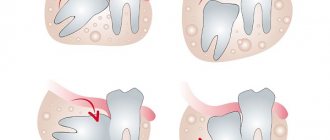Facial swelling is not only a cosmetic defect; if it appears frequently or is accompanied by redness and pain, it is a sign of quite serious health problems that need to be identified and treated.
ALENA PARETSKAYA
Pathophysiologist, immunologist, member of the St. Petersburg Society of Pathophysiologists ANDREY GRACHEV Leading cardiologist of the SM-Clinic holding, MD, academician of the Russian Academy of Medical Sciences
Facial edema is not a separate disease, but only a reflection of an imbalance between retention and excretion of fluid in the body. But what problems in the body can cause the face to swell and how serious is it?
Why does the face swell in adults?
Swelling on the face can occur at different times of the day - mainly in the morning or late afternoon, or they persist throughout the day, decreasing or increasing.
There are two types of reasons:
- physiological (or natural, not associated with diseases), they are usually not pronounced, not very strong, and disappear quickly;
- pathological, can be very strong, with changes in facial features, signs of inflammation, and are often quite persistent.
Each type of edema has the most typical causes; they occur mainly in the morning or evening hours, or do not depend in any way on the time of day. These characteristics are important for the doctor so that he can identify the leading causes and determine the tactics of examination and treatment.
Diagnostics
Diagnosis of diseases that are accompanied by swelling of the nasal cavity is carried out by otolaryngologists. The examination program includes a survey, during which the specialist determines the time and circumstances of the appearance of swelling and other symptoms, their relationship with various external and internal factors. The doctor conducts an external examination and prescribes the following diagnostic procedures:
- Rhinoscopy.
Allows you to confirm the presence of inflammation, deformities, tumors, polyps, foreign bodies and traumatic injuries. - Lab tests
. A microbiological examination of nasal discharge is performed to detect bacterial infections, and RIF to detect viral diseases. For tumors, histological or cytological examination is prescribed. - Radiography
. In case of injuries, photographs of the nose are taken, and if sinusitis is suspected, X-rays of the paranasal sinuses are taken.
The listed methods can be supplemented by allergy tests, studying the condition of the pharynx and larynx during pharyngoscopy and laryngoscopy, and other studies.
Rhinoendoscopy
Is there swelling on the face due to heart disease?
Yes, these questions usually worry women, says cardiologist Andrei Grachev.
They run to see a cardiologist when they can’t put a ring on their finger in the morning because it’s swollen or put on makeup because their face is swollen. The patient wants to look great, regardless of age and health status. And this is commendable. Men, as a rule, do not contact a cardiologist with such questions. The peculiarity of this issue is due to the fact that in patients with cardiovascular diseases, as a rule, swelling on the face appears at the final stage of a complication such as heart failure. First, they appear on the legs (the lowest point in relation to the heart), then fluid accumulates in the abdominal cavity, the liver and spleen enlarge (as a blood depot). And only after the fluid reaches the pleural cavities and the heart sac, swelling may occur on the face or hands.
Nasopharyngeal cancer
With a tumor of the nasopharynx, the symptoms of the disease can be widespread and less common. Early manifestations of nasopharyngeal cancer are nasal congestion, a burning sensation in the throat, swollen lymph nodes, and ear congestion. The symptoms are similar to those of a cold. The tumor begins to progress rapidly and is manifested by the following symptoms: nosebleeds, hearing loss, sore throat, nasal congestion, frequent headaches, enlarged cervical lymph nodes, squint on one side, a feeling of numbness in the face, difficulty opening the mouth, non-healing in the nasopharynx. wounds.
Nasopharyngeal cancer is dangerous because the disease is asymptomatic in the early stages of development. Very often, the symptoms of cancer resemble the symptoms of colds. When oncology of the nasopharynx is detected, the symptoms most often indicate a late stage of cancer - an unpleasant putrid odor appears from the mouth, the patient feels an unpleasant odor that comes from the nasal sinuses, headaches are tormented, the vocal cords swell, the voice changes, the patient has difficulty swallowing, opening the mouth.
Nosebleeds are a constant concern, the body temperature periodically rises, tachycardia worries, speech becomes incoherent, strabismus and paralysis of the facial nerves may develop. Stage 4 nasopharyngeal cancer is characterized by general weakness, severe symptoms, severe pain in the nasopharynx, neck, and headaches.
When do they occur most often?
Due to a number of circumstances, adds cardiologist Andrei Grachev, such as the flow of fluid to the upper half of the body in a lying position, changes in the biorhythms of hormone production (more often their active synthesis occurs at night or in the early morning hours), edema syndrome most often manifests itself in the early morning hours .
Morning
If we talk about physiological reasons, morning swelling is usually associated with constant lack of sleep, fasting or strict diets (limiting protein and fats). Sometimes swelling in the morning is caused by the wrong selection of skincare products (face cream, toner or cleanser). Also, morning swelling of the face can be caused by crying or stress in the evening or at night.
Possible swelling of the face in the morning due to an incorrectly selected pillow (it is too high, it provokes a narrowing of the blood vessels in the neck). Another physiological factor is an excess of fried, salty foods or liquids taken in the evening, before bed. In women, facial swelling in the morning can be caused by hormonal fluctuations, PMS or pregnancy. Some women report morning swelling during menopause.
Pathological causes of morning edema are mainly kidney damage. Such swelling is usually soft, mobile, appears on the face after sleep, and the skin acquires a waxy or yellowish tint. The most common causes of facial swelling are:
- glomerulonephritis - the acute form of the disease leads to edema, which lasts up to 2-3 weeks, if the process enters the chronic phase, edema is typical for periods of exacerbation of inflammation;
- Kidney amyloidosis - edema is typical of the second stage (proteinuria), when protein loss occurs and kidney function gradually deteriorates;
- membranous nephropathies - occur after taking certain medications, tumor therapy, acute infectious pathologies. Edema occurs in waves, with sharp or barely noticeable symptoms;
- chronic kidney disease (previously called renal failure) - swelling occurs gradually as renal damage progresses;
- kidney damage in severe systemic pathologies - edema is typical for nephropathy due to diabetes or systemic lupus erythematosus.
Evening
Sometimes facial swelling becomes noticeable in the evening, especially after an active day. Often this is one of the manifestations of pathologies of the cardiovascular system. Often, swelling of the face is accompanied by severe swelling in the area of the extremities - hands and feet, legs. These swellings are denser, the skin has a lower temperature than on other parts of the body, and such swelling goes away slowly. Often occur against the background of the following pathologies:
- amyloidosis of the heart and blood vessels;
- cardiomyopathy;
- sclerotic heart disease (cardiosclerosis);
- certain types of arrhythmia;
- constrictive pericarditis;
- some heart defects;
- arterial hypertension;
- cardiac lesions due to rheumatism.
Day
Sometimes facial swelling is most pronounced during the day or its appearance is not clearly related to the time of day. Among the main pathologies that lead to such edema are endocrine disorders - especially a lack of thyroid hormones (hypothyroidism). Facial swelling is especially pronounced with congenital hypothyroidism, in pregnant women or with autoimmune thyroiditis, cytokine-induced thyroiditis.
Rapidly increasing swelling of the face during the day can be a sign of allergies - to food, insect bites, cosmetics, medications and even cold. Sometimes facial swelling occurs during an attack of bronchial asthma due to difficulty breathing and fluid retention in the veins.
Facial swelling is possible in people who smoke and drink alcohol. This is due to the increased work of the lymphatic system to remove toxins from tissues.
Severe swelling of the face during the day is possible with respiratory infections and their complications - sinusitis, tonsillitis, frontal sinusitis. Swelling of the face is possible with a deficiency or excess of vitamins (especially fat-soluble ones).
Nasal hemangioma and other benign tumors of the nose
Benign nasal tumors are formed from various tissues present in the nose and paranasal sinuses. Hemangioma is a benign tumor that most often develops in the first days of a child’s life and actively grows in the first six months of his life. After the child is one year old, the tumor begins to involute; most of the hemangiomas disappear by the age of seven, the rest by the age of twelve. More often, hemangiomas form in girls. The cause of the disease is a disturbance in the development of blood vessels in the embryonic period. Nasal hemangioma can grow deep into the skin, tissues of the organ and to the sides, destroy tissues, provoke bleeding, and disrupt the functions of the organ.
Nasal fibroma is a benign formation that can spread to the orbit. Nasal fibroma is rare, characterized by active growth and quickly grows into the orbit and paranasal sinuses. The tumor causes nosebleeds and nasal congestion. Fibroma that has grown into the orbit and nasal sinuses causes various complications: constant lacrimation, decreased visual acuity, exophthalmos, and can cause deformation of the skull bones. Fibroids rarely develop in the paranasal sinuses, most often developing in the maxillary sinus.
Adenomas in the nose can be true adenomas, a papilloma-like tumor, or a malignant destructive adenoma. Adenomas do not produce secretions, despite the fact that the tumor contains glandular epithelium. Adenomas in the nose are rare and are characterized by nosebleeds, nasal congestion, and can lead to the development of exophthalmos, purulent dacryocystitis and other complications.
Benign neoplasms of the nose are osteoma, chondroma, angioma, papilloma, chordoma, lipoma, myxoma, bleeding polyp, ganglioneuroma, dermoid cyst and other neoplasms. Tumors are formed during intrauterine development of the fetus with a negative impact on the woman’s body during pregnancy. They can appear in chronic diseases of the nasopharynx; the appearance of tumors is influenced by poor environmental conditions, injuries, and infections.
How to quickly relieve facial swelling in adults
If this is physiological swelling of the face, not associated with serious pathologies that require medical supervision and the use of selected medications, excess fluid can be eliminated through certain simple measures and actions.
Taking a contrast shower or washing with cold/hot water. This method refreshes, increases tissue tone, enhances the outflow of fluid from the skin and reduces swelling.
Using ice – a couple of pieces of ice will help deal with swelling on the face quickly and effectively. In addition, you can prepare herbal decoctions with a tonic effect in advance and freeze them, using them for washing.
Facial massage is an effective remedy that helps improve microcirculation and swelling. Manual massage, the use of rollers, ice cubes, and cold spoons help. Sometimes you can first wipe your face with green tea and apply compresses with it to your face and eye area.
Treatment
Pre-hospital assistance
Patients with a tendency to develop swelling of the nasal mucosa are advised to refrain from contact with strong-smelling substances, install an air humidifier, wear a hat in winter, and avoid swimming in cold ponds and pools. Patients with allergic reactions should, if possible, avoid contact with allergens and, if necessary, take antiallergic medications. For short-term swelling, you can use vasoconstrictors yourself. In case of persistent swelling, you need to consult a specialist.
Conservative therapy
For the treatment of diseases accompanied by swelling of the nasal cavity, the following methods are recommended:
- Adrenergic agonists
. To ease breathing, they are prescribed in the form of drops and used for 1 or 2 weeks. Long-term use is undesirable, as it can lead to the development of vasomotor rhinitis. - Antiallergic drugs
. Mast cell membrane stabilizers and antihistamines can quickly reduce swelling, improve nasal breathing, and eliminate other allergy symptoms. - Glucocorticosteroids
. Nasal sprays with hormones reduce swelling, reduce the amount of discharge, and reduce the sensitivity of the mucous membrane to irritants. Prescribed for vasomotor and allergic rhinitis, nasal polyps. - Antibiotics
. Effective for inflammatory otolaryngological diseases: chronic rhinitis, frontal sinusitis, sinusitis. At the initial stage, broad-spectrum medications are administered, then antibiotic therapy is adjusted taking into account the sensitivity of the pathogen. - Physiotherapy
. Drug electrophoresis, microwave therapy, darsonvalization, and some other techniques are used.
Surgery
If indicated, surgical interventions are performed for the following diseases and conditions:
- Hypertrophic rhinitis: conchotomy.
- Deviated nasal septum: septoplasty, rhinoseptoplasty.
- Sinusitis: maxillary sinusotomy or frontotomy.
- Volume formations: removal of polyps and tumors.
Some operations are performed not only openly, but also endoscopically, which makes it possible to reduce the traumatic nature of manipulations and shorten the rehabilitation period. It is possible to use various energies: laser, radio wave radiation, etc.
Signs of a malignant process
The root cause of the development of nasal cancer has not been determined. There are risk factors that provoke the appearance of a tumor:
- Active (to a greater extent) and passive smoking.
- Work in hazardous industries: interaction with flour dust, wood, textiles, leather goods.
- Prolonged contact with radium, chrome and nickel dust, formaldehyde, solvents, and other chemical compounds.
- Chronic forms of various variants of sinusitis, rhinitis.
- Alcohol abuse.
- Long stay in a place with unfavorable ecology.
- Viral infection (for example, human papillomavirus).
When determining the stage of nasal cancer, experts pay attention to the following points:
- The spread of the process to other sinuses, soft tissues of the face, bone fragments.
- The presence or absence of metastases in regional lymph nodes - those closest to the diseased organ.
- The presence or absence of metastases distant from the lesion.
Prevention
There are certain precautions that will prevent cancer of the nose and sinuses:
- treat chronic inflammation, as well as benign neoplasms that have arisen in the nose;
- when working in industries that can cause harm to health, use means that provide personal protection;
- give up all habits that are harmful;
- Consult a doctor promptly if you notice symptoms of sinus cancer.










